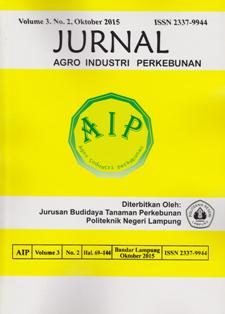Pengaruh Pemberian Serat Kelapa Sawit dan Urine Sapi pada Pertumbuhan Bibit Kakao (Theobroma cacao L.)
DOI:
https://doi.org/10.25181/aip.v3i2.25Abstract
Cocoa plants are plantation crops that have high economic value and stable. Cocoa prospects quite good because the market demand is very big commodity. The research was conducted in field trials, Lampung State Polytechnic, from September 2014 up to February 2015. Experiments conducted with factorial randomized block design with 2 factors and any combination treatment was repeated three times. The first factor, namely the provision of oil palm fiber to the growing media consisting of 0% oil palm fiber and 100% soil, 25% oil palm fiber and 75% land, 50% oil palm fiber and 50% of the land. The second factor, namely the provision of liquid organic fertilizer of cow urine which consists of 0 ml of cow urine, cow urine of 40 ml, 80 ml of cow urine, cow urine and 120 ml. This study was conducted to determine the effect of oil palm fiber and cow urine, as well as the provision of fiber interactions palm and cow urine on the growth of cocoa seedlings. The results showed the provision of oil palm fiber 0% gives better results than the 25% and 50% in high-seed, stem diameter, number of leaves, dry weight and root length stover. Giving cow urine of 40 ml to 120 ml showed better results than without the provision of cow urine on seedling height, stem diameter, number of leaves, dry weight stover, and root length. In general, oil palm fiber giving no effect on the growth of cocoa seedlings and cow urine giving a dose of 40 ml to 120 ml to give effect to the growth of cocoa seedlings. There is interaction granting palm fiber and cow urine on a number of leaves and length of plant roots.Keywords: cocoa seed, cow urine, fiber palm oilPermalink: http://jurnal.polinela.ac.id/index.php/AIP/article/view/25Downloads
References
Affandi. 2008. Pemanfaatan Urine Sapi yang Difermentasi Sebagai Nutrisi Tanaman http://affandi21.xanga.com/644038356/pemanfaatan-urine-sapi-yang-difermentasi-sebagai-nutrisi-tanaman/. [Diakses 4 September 2014].
Badan Penelitian Tanah dan Pengembangan Pertanian Bogor. 2008. Panduan Praktis Budidaya Kakao. Badan Penelitian Tanah dan Pengembangan Pertanian Bogor.
Brady, N. C. 1990. The Nature and Properties of Soil. 10th ed. MacMillan Publishing Co. New York.
Cahyono, B. 2003. Teknik dan Strategi Sawi Hijau. Yayasan Pustaka Nusantara. Yogyakarta.
Fauzi,Y. 2004. Kelapa Sawit. Edisi Revisi. Cetakan ke-14. Penebar Swadaya. Jakarta.
Gardner. 1991. Fisiologi Tanaman Budidaya. UI Press. Jakarta.
Lingga, P. 1991. Jenis Kandungan Hara pada Beberapa Kotoran Ternak. Pusat Penelitian Pertanian dan Pedesaan Swadaya. Antanan. Bogor.
Murbandono, H. S. 1998. Membuat Kompos. Penebar Swadaya. Jakarta.
Musnamar, E. I. 2005. Pupuk Organik. Penebar Swadaya. Jakarta.
Utomo, B dan E. Widjaja. 2004. Limbah padat pengolahan minyak sawit sebagai sumber nutrisi ternak ruminansia. Balai Pengkajian Teknologi Pertanian Kalimantan Tengah. Palangkaraya. (http://www.pustakadeptan. go.id/publikasi/p3231044.pdf). [Diakses 7 Agustus 2008].
Pangaribuan, D. dan H. Pujisiswanto. 2008. Pemanfaatan Kompos Jerami untuk Meningkatkan Produksi dan Kualitas Buah Tomat. Prosiding Seminar Nasional Sains dan Teknologi-II. Jurusan Budidaya Pertanian Fakultas Pertanian Universitas Lampung. Lampung. Vol: 1-10.
Roswarkam, A. Dan Yuwono, N, W. 2002. Ilmu Kesuburan Tanah. Kanisius. Yogyakarta.
Salisbury, F. B. and C. W. Ross. 1995. Fisiologi Tumbuhan. Jilid ketiga. Terjemahan dari: Plant Physiology. Penerjemah: D.R. Lukman dan Sumaryono. ITB. Bandung.
Suprijadji, G. 1988. Pengamatan Kualitatif Auxin, Kinetin, Gibberelin Pada Urine Sapi, Kambing, dan Domba. Warta BPP Jember. Jember.
Downloads
Published
How to Cite
Issue
Section
License
Authors who publish with Jurnal Agro Industri Perkebunan agree to the following terms:
Authors retain copyright and grant the Jurnal Agro Industri Perkebunan right of first publication with the work simultaneously licensed under a Creative Commons Attribution License (CC BY-SA 4.0) that allows others to share (copy and redistribute the material in any medium or format) and adapt (remix, transform, and build upon the material for any purpose, even commercially) with an acknowledgment of the work's authorship and initial publication in Jurnal Agro Industri Perkebunan.
Authors are able to enter into separate, additional contractual arrangements for the non-exclusive distribution of the journal's published version of the work (e.g., post it to an institutional repository or publish it in a book), with an acknowledgment of its initial publication in Jurnal Agro Industri Perkebunan. Authors are permitted and encouraged to post their work online (e.g., in institutional repositories or on their website) prior to and during the submission process, as it can lead to productive exchanges, as well as earlier and greater citation of published work.


























